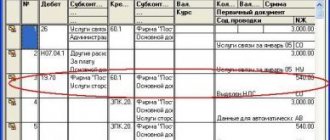For whom the new FSBU 5/2019 “Reserves” has been released?
Federal Standard 5/2019 was approved by Order of the Ministry of Finance dated November 15, 2019 No. 180n.
Accountants will begin working on the basis of the new provisions without fail from January 1, 2021. However, those who wished could use them already in the current year by including a condition regarding this in the accounting policy. All organizations conducting accounting and reporting in accordance with domestic legislation will have to fulfill the requirements laid down in the standard. An exception is provided only for companies operating in the public sector. Small enterprises, which were allowed by Law No. 402-FZ to keep records according to simplified rules, will be able to choose for themselves whether to apply the standards in their work or not.
Review of general and transitional provisions
The provisions of the Standard “Inventories” are mandatory for use by government, budgetary and autonomous institutions, government bodies, management bodies of state extra-budgetary funds and local government bodies, as well as organizations exercising powers to maintain accounting (budgetary) records of institutions.
More on the topic: Privatization of housing in budget accounting
The “Inventories” standard is applied unless otherwise provided by other regulatory legal acts regulating the maintenance of accounting (budget) accounting and the preparation of accounting (financial) statements * (1), as well as other Federal standards applied since 2021. In addition, as with other current Federal Standards (for example, the “Rent” or “Fixed Assets” Standards*(2)), the “Inventory” Standard is applied simultaneously with the application of the provisions of the “Conceptual Framework...” Standard*(3).
The Inventories standard does not apply for accounting purposes:
- library collections, regardless of their useful life;
- living organisms (animals, plants, fungi) cultivated to obtain biological products (including wood), whose natural growth and restoration are under the direct control, responsibility and management of the accounting entity (biological assets);
- work in progress formed by the accounting entity based on the results of its performance as a contractor under construction contracts;
- objects related to cultural heritage assets;
- financial instruments.
The fact is that to account for these objects, the relevant federal standards are applied, for example, the accounting of library collections and objects related to cultural heritage assets is carried out in accordance with the provisions of the Standard “Fixed Assets”.
The transitional provisions under the Inventory Standard generally resemble the transitional provisions under the Lease and Fixed Assets Standards. Briefly they can be characterized as follows:
- Items that were not recognized as inventories and (or) reflected in off-balance sheet accounting prior to the first application of the Inventories Standard, and in accordance with its provisions should be reflected in the relevant balance sheet accounts, are recognized as inventories at their original cost, subject to the condition, that they correspond to the concept of an asset * (4);
- information on inventories established before the first application of the Inventories Standard is not recalculated.
Adjustment of opening balances is carried out during the inter-reporting period using account 401 30 “Financial result of previous reporting periods”. The result is documented in an Accounting Certificate (f. 0504833). And information about changes is reflected in Information on changes in balance sheet currency balances (form 0503173), Information on changes in balance sheet currency balances of an institution (form 0503773).
What applies to reserves according to FSBU 5/2019
The definition that the federal standard gives to the concept of “reserves” is as follows:
This concept, in comparison with what PBU 5/01 gave, has been expanded by including new elements in the list:
In general, the list includes:
The ready-made K+ solution will tell you how to record the transfer of uniforms to employees when applying FSBU 5/2019. Sign up for a free trial and view all the content that interests you.
The standard also contains an indication of what does not apply to reserves. This:
- financial assets;
- valuables belonging to other persons, but located in the organization, for example, in storage, processing, maintenance;
- valuables received by a non-profit organization for subsequent free transfer to other persons.
Next, we will consider in what cases inventories are recognized and how they are valued in accounting.
FSBU 5/2019 “Inventories”, reflected in 1C: Accounting 8.3
In connection with the updating of Russian standards and convergence with IFRS, the topic of transition and application of FSBU 5/2019 is quite relevant. In this article we will look at the main points of FSBU 5/2019 “Inventories”: differences compared to the current standard, reflected in 1C: Accounting 8.3.
It is worth noting the main innovations of the FSBU “Reserves”.
- Inventories cover the entire operating cycle, including work in progress.
- Costs of inventory for management purposes can be recognized as expenses immediately.
- The amount of costs when paid with deferment (installments) is discounted.
- It is prohibited to include a number of costs in the cost of inventories, including:
a) costs caused by improper organization of the production process;
b) costs due to emergency situations;
c) impairment of other assets;
d) administrative expenses, except in cases of direct connection with production;
e) storage costs, with the exception of technological reasons;
f) expenses for advertising and promotion of products.
- No income is recognized when inventory is received from the disposal of property, plant and equipment.
- Inventories in agriculture, forestry and fisheries can be measured at fair value.
- WIP cannot be valued only by the cost of raw materials, materials and semi-finished products.
- Costs are measured at the reporting date at the lower of cost and net realizable value.
- Expenses include the book value of inventories sold (including provisions).
- The reversal of past impairments reduces ordinary operating expenses.
- Inventories from which no economic benefit is expected are written off.
- There are special disclosure requirements, including numerical reconciliation of inventory movements.
Who will be affected by the changes and who will not? Let's look at the categories.
1) Microenterprises (STS) and most NPOs may not keep records
Consider micro-enterprises that may not apply the standard. What does it mean not to apply? You don’t take into account the materials in any way; if you paid for them, they don’t take them into account, they don’t show them on the balance sheet, they immediately write them off as expenses.
For micro-enterprises using the simplified tax system, in the document “Write-off from the current account”, the field “Without closing documents” appears, that is, accounting is carried out using the cash method, without the Federal Accounting Service, posting Dt 26 Kt 51 is generated.
2) Small businesses can refuse most changes
Accounting according to the Federal Accounting Standards may be needed, or rather, its individual provisions. There are a number of changes that are advisable to apply. For example, the new standard does not allow items with a useful life of more than 12 months to be included in the cost of inventory; administrative expenses; non-standard expenses.
| Until 2021 | From 2021 |
| Cheaper than 40,000 - stocks Workwear - supplies Less than a year - reserves | Less than a year - reserves More than a year - fixed assets Non-essential - expenses |
Here you can refer to the recommendations of BMC R-100 “Implementing the requirement of rationality.” For example, for a plant, industrial equipment is fixed assets; office furniture - expenses. It should be stated in the accounting policy that some objects are not included in fixed assets, despite their use for more than a year.
Let's consider the class of objects that we write off immediately upon acquisition, that is, inexpensive, insignificant. The document “Advance report” - the “Other” tab, bypassing account 10, is immediately included in expenses.
Another variant. You are an income tax payer and must have supporting documents. We reflect it as a receipt to account 10, then write it off with the document “Demand-invoice”, that is, we wrote off the amounts from account 10 and included them in expenses for tax accounting purposes.
Frequently asked question: how to take into account workwear? There are several options: ignore; take into account on the balance sheet; accounted for as fixed assets.
3) Comply with all the requirements of the standard - medium and large enterprises, individual non-profit organizations and organizations subject to mandatory audit
Changes for medium and large enterprises: classification of advances; accounting at planned cost; impairment of inventories.
The standard requires that advances issued for the purchase of inventories should be shown in the same way as inventories on the balance sheet. Not every advance needs to be classified this way, only significant ones.
Therefore, it is planned to add in the contract such a choice as “Reflect the advance in all versions of 1C: Accounting 8.3 - Basic, PROF, CORP.
In this article, we examined the main points of FSBU 5/2019 “Inventories”: differences compared to the current standard, reflected in the 1C: Accounting 8.3 program. If you have any questions, please contact the 1C Consultation Line, whose specialists will provide you with qualified support. The first consultation is completely free!
How the assessment rules have changed
The main innovation of the federal standard is that now inventories will have to be assessed twice - upon receipt and after recognition. Moreover, in the first case, the rules for valuing different types of reserves will differ significantly from each other.
Valuation of inventories at recognition
All inventories must be recognized at actual cost. But what will shape it?
Inventories excluding finished goods and work in progress
For the bulk of inventories, the actual cost will be the amount of expenses aimed at acquiring assets, delivering them, and bringing them to a condition suitable for use or sale.
If inventories are received free of charge or settlements with their supplier are made in non-cash terms, then the inventories will have to be measured at fair value. In the first case - supplies received free of charge. In the second - the transferred property. This value is determined by IFRS 13 Fair Value Measurement.
Important! Costs associated with storage will no longer form the actual cost of inventories, except in cases where storage is one of the cycles of the technological process.
Work in progress and finished goods
The actual cost of these types of inventories is formed by the following costs:
- material;
- for wages;
- social security contributions;
- depreciation.
In accounting, a business entity must divide all costs into direct and indirect. The procedure for such division is best provided for in accounting policy. Direct costs will be attributed to specific products, and indirect costs will have to be distributed by type. Methods of distribution should also be reflected in accounting policies.
Nuances of recognizing inventory upon receipt
For certain categories of business entities, the FSB determines the nuances of recognizing inventories.
- Organizations that keep records in a simplified way have the right to recognize values without taking into account discounts and deferment conditions.
- Retail companies will be able to recognize goods at sales price with separate accounting for markups.
- For trading enterprises, funds spent on the procurement and delivery of goods to central warehouses are taken into account in sales costs.
Valuation of inventories after recognition
We have already become acquainted with the first quantity, let’s deal with the second. Net realizable value is the price less the estimated costs of producing, preparing for sale and selling inventory.
If actual cost exceeds net realizable value, inventory is impaired. This usually happens over time, due to obsolescence, etc. In this case, the organization is required to create a reserve for the amount of the specified excess. The book value will be formed from the actual cost of inventories minus the reserve.
For organizations with simplified accounting, creating a reserve is not necessary.
"Regular" stocks
The cost of those inventories that are not classified as work in progress and finished products includes the actual costs of acquiring (creating) and bringing them into the condition necessary for consumption, sale or use. Costs are listed in paragraph 11 of FSBU 5/2019. Among them there are quite traditional ones:
- amounts paid and (or) payable to the supplier (seller, contractor;
- costs of procurement and delivery to the place of consumption (sale, use);
- costs of bringing the inventory to a state in which it is suitable for use (refinement, sorting, packaging and improving technical characteristics);
- other costs associated with the acquisition (creation) of inventories.
In addition to these costs, the actual cost of inventories also includes:
- the amount of the estimated liability for dismantling, disposal of reserves and restoration of the environment;
- interest associated with the acquisition of an investment asset (previously they were written off as other expenses).
These two types of “non-traditional” costs for inventories were extended to their accounting by analogy with accounting for fixed assets.
The cost of purchased (created) inventories does not include (clause 18 of PBU 5/2019):
- costs incurred in connection with natural disasters, fires, accidents and other emergency situations. Previously - turned on;
- administrative expenses, except when they are directly related to the acquisition (creation) of inventories;
- storage costs, if it is not part of the technology for preparing inventories for consumption (sale, use) or is not conditioned by the conditions for the acquisition (creation) of inventories. Previously, they were included without reservations;
- other costs, the implementation of which is not necessary for the acquisition (creation) of inventories (will have to be decided in each specific case).
We write off inventories - what has been updated
The new standard requires inventory to be written off at a specific point in time. It could be:
- recognition of sales revenue;
- making other write-offs of inventories;
- lack of prospects for economic benefits from further use;
- impossibility of use in statutory activities - for non-profit organizations.
In this case, expenses should reflect the book value of inventories. For each of these cases, costs will be taken into account separately.
The methods for writing off inventories remain the same as those currently in effect and are enshrined in PBU 5:
- at the cost of each unit;
- at average cost;
- at the cost of the first inventory received by the organization - the FIFO method.
The chosen method must be fixed in the accounting policy.
How to reliably disclose information about reserves in reporting
The amount of information that must be disclosed in the financial statements regarding reserves is large. In addition to the book value at the beginning and end of the reporting period, it is necessary to reflect information regarding:
- reconciliation of inventory balances at actual cost and impairment at the beginning and end of the reporting period and inventory movements for the same period;
- the reasons that led to the restoration of the reserve;
- the book value of assets for which the organization has restrictions, for example collateral;
- methods for calculating the cost of inventories, and if they change in the new reporting period, it is necessary to disclose information about the consequences of such a change;
- advances and deposits transferred to suppliers, carriers and inventory processors.
How to apply FSB 5/2019 from January 1, 2021
There are significant differences between the provisions of the previously used PBU 5/01 and FAS 5/2019 “Inventories”, therefore it is necessary to establish the transition method in the accounting policy:
- Prospective - the provisions begin to apply only to those facts of activity that occurred after the implementation of the standard, i.e. after January 1, 2021.
- Retrospective - the provisions of the standard apply not only to future periods, but also to past periods. In this case, account balances are recalculated in accordance with the new requirements.
When choosing the retrospective option of switching to a new standard, it is necessary to adjust the indicators in correspondence with score 84.
Here are examples of transactions in accordance with FAS 5/2019, if the organization chooses the second method:
| Dt | CT | Post content |
| 84 | 10 | Write-off of the value of material assets previously acquired for management needs |
| 41, 43 | 84 | Bringing the accounting value of goods and finished products to fair value as of the date of transition to FAS 5/2019 |
| 84 | 41, 43 |
In the ready-made solution from K+ you will find examples of other accounting entries when transitioning to a new standard in a retrospective manner. Get free trial access to the system.
Work in progress and finished goods
The actual cost of work in progress and finished products includes costs associated with the production of products, performance of work, and provision of services (clause 23 of FSBU 5/2019). Such costs include:
- material costs;
- labor costs;
- contributions for social needs;
- depreciation;
- other costs.
They, in turn, are divided into direct and indirect (clause 24 of FSBU 5/2019). Each company determines the classification of costs into direct and indirect independently.
The actual cost of work in progress and finished products does not include (clause 26 of FSBU 5/2019):
- costs incurred due to improper organization of the production process (excessive consumption of raw materials, materials, energy, labor, losses from downtime, defects). Previously, they were turned on;
- administrative expenses (if they are not directly related to production);
- storage costs, if they are not related to the technology of production, performance of work, provision of services. Previously, they were included without reservations;
- other costs that are not necessary for the production of products (performance of work, provision of services).
Please note that starting from 2021, the procedure for the subsequent assessment of inventories, their write-off, as well as the restoration of the reserve for impairment of inventories will change.
Results
From 01/01/2021, most organizations will have to introduce into their work the norms of the new accounting standard FSBU 5/2019. Reporting for 2021 will be prepared in accordance with them. FSBU is not used in the public sector, and “kids” will be able to choose whether or not to use it in their work. In addition, the standard itself offers various concessions to organizations that keep records in a simplified way.
The replacement of the old PBU with the new FSBU led to significant changes in inventory accounting. The changes affected work in progress, which previously did not belong to the concept of “inventories,” the assessment of inventories, the procedure for their write-off, and the rules for disclosing information about inventories in reporting.
Sources:
- Order of the Ministry of Finance of Russia dated November 15, 2019 No. 180n “On approval of the Federal Accounting Standard FSBU 5/2019 “Inventories””
- Accounting Regulations “Accounting for Inventories” PBU 5/01
You can find more complete information on the topic in ConsultantPlus. Free trial access to the system for 2 days.
FSBU "Reserves": features of the document
FSBU “Inventories” was approved by Order of the Ministry of Finance of the Russian Federation No. 180 dated November 15, 2019. The country's main financial department, in information message No. IS-accounting-27 dated April 10, 2020, explained the main aspects of the new document.
The point of view of FSBU 5/2019 on many issues of inventory accounting is noticeably at odds with the usual standards of PBU 5/01. Thus, the new standard generalizes the concept of “material reserves” - now it is simply “reserves”. They will have to be assessed twice - upon recognition in accounting and after it. The procedure for assessing inventories and forming the actual cost of assets has been changed.
The range of assets related to inventories has been expanded, in particular, due to items of work in progress (WIP), which were not previously recognized as such. In addition, the standard includes a new term – “fair value”. It is calculated based on IFRS standards in certain situations.
The standard defines inventories as assets that are used or sold by an enterprise in its normal cycle of operations, or in a period not exceeding 12 months. This:
- inventory, raw materials, fuel, spare parts, components, purchased semi-finished products for further production;
- inventory, tools, special clothing, special equipment, containers, except for situations where such objects are recognized in accounting as fixed assets;
- goods, real estate, intellectual property and manufactured finished products (GP) intended for sale;
- GP and goods in the process of sale until revenue is recognized;
- costs for the production of products that have not passed all stages of the technical process, are incomplete, have not passed testing and acceptance of the product, as well as costs attributable to the performance of work/services until revenue is recognized, i.e. WIP (work in progress).
Financial assets and values that do not belong to the company, for example, inventory items in storage, in transportation, or received by non-profit organizations for subsequent transfer to third parties, will not be classified as inventories.



